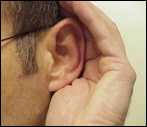Mining Topic: Hearing Loss Prevention Overview
What is the health and safety problem?
One out of every four mine workers has a hearing problem. Even worse, four out of five mine workers have a hearing impairment when they reach mid-60’s retirement age. Hazardous noise is the primary culprit – 76% of mine workers are exposed to hazardous noise, the highest prevalence of all major industries.
What is the extent of the problem?
Noise-induced hearing loss (NIHL) is a permanent affliction that interferes with a mine worker’s ability to communicate with family, friends, and co-workers. It also creates a safety hazard when mine workers are unable to hear moving machinery and warnings. In addition, many afflicted with NIHL also experience tinnitus—a ringing or buzzing sound that persists in the absence of any real sound—which can be intensely stressful and annoying.
How is the NIOSH Mining program addressing this problem?

Trouble hearing.
NIHL is being addressed in all areas of the mining industry, including both surface and underground for all commodities. Initially, the noise control efforts concentrated on underground coal mine noise and produced solutions for continuous mining machines, roof bolting machines, and the vibrating screens used in preparation plants. Current work by NIOSH Mining is addressing mobile equipment in underground metal/nonmetal mines with an emphasis on haul trucks.
The ultimate strategic goal of this research program is to reduce NIHL in the mining industry. To accomplish this goal, the program will:
- Develop durable and practical noise controls for mining equipment.
- Attain widespread industry implementation of noise controls.
- Evaluate the short-term and long-term effectiveness of noise controls by acquiring surveillance data.
What are the significant findings?
A dual-sprocket continuous mining machine chain was developed that reduced sound levels by 2-3 dB(A) at the operator ear. It was commercialized by Joy Mining Machinery in 2008 and had been implemented on over 30% of the machines in the U.S. by 2012.
A drill bit isolator based on NIOSH Mining technology was found to reduce noise reaching the operator ear by 2-5 dB(A). It was commercialized by Corry Rubber and Kennametal in 2011.
A dual-sprocket urethane-coated continuous mining machine chain was developed and was found to reduce noise reaching the operator ear by 5-7 dB(A). It was commercialized by Joy Global in 2012
What are the next steps?
The program is evaluating additional metal/nonmetal machines for noise hazards to be addressed through noise controls. NIOSH Mining researchers are also developing an enhanced modeling capability to develop noise controls more efficiently and conduct evaluations in the simulated acoustic environment of a computer-modeled mine.
See Also
- Administrative Controls for Reducing Worker Noise Exposures
- Application of Phased Array Technology for Identification of Low Frequency Noise Sources
- CAP the Noise to Save your Hearing!
- Cross-Sectional Survey of Noise Exposure in the Mining Industry
- Determining Underground Roof Bolting Machine Operators Noise Exposure Using Laboratory Results
- DOSES - Determination of Sound Exposures - 1.1
- Engineering Noise Controls for Haul Trucks and Load Haul Dumps (LHDs)
- Equipment Noise and Worker Exposure in the Coal Mining Industry
- An Evaluation of Sound Restoration Hearing Protection Devices and Audibility Issues in Mining
- Hearing Loss in the Mining Industry: The Evolution of NIOSH and Bureau of Mines Hearing Loss Research
- HLSim - NIOSH Hearing Loss Simulator - 3.0.1215.1
- How Can I Test My Hearing Protection?
- Noise Control in Underground Metal Mining
- Noise Exposure in Longwall Mining and Engineering Controls Research
- A Technique for Estimating the Sound Power Level Radiated by Pneumatic Rock Drills and the Evaluation of a CSIR Prototype Rock Drill with Engineering Noise Controls
- Technology News 531 - Engineering Controls for Reducing Continuous Mining Machine Noise - TN-No. 531
- Technology News 548 - Bit Isolator Reduces Drilling Noise in Underground Coal Mines
- Underground Evaluation of Coated Flight Bars for a Continuous Mining Machine
- Water Well Safety Bits: Health And Safety Information For The Water Well Industry
- What Does a Hearing Loss Sound Like?
- Page last reviewed: 2/17/2017
- Page last updated: 9/21/2015
- Content source: National Institute for Occupational Safety and Health, Mining Program


 ShareCompartir
ShareCompartir